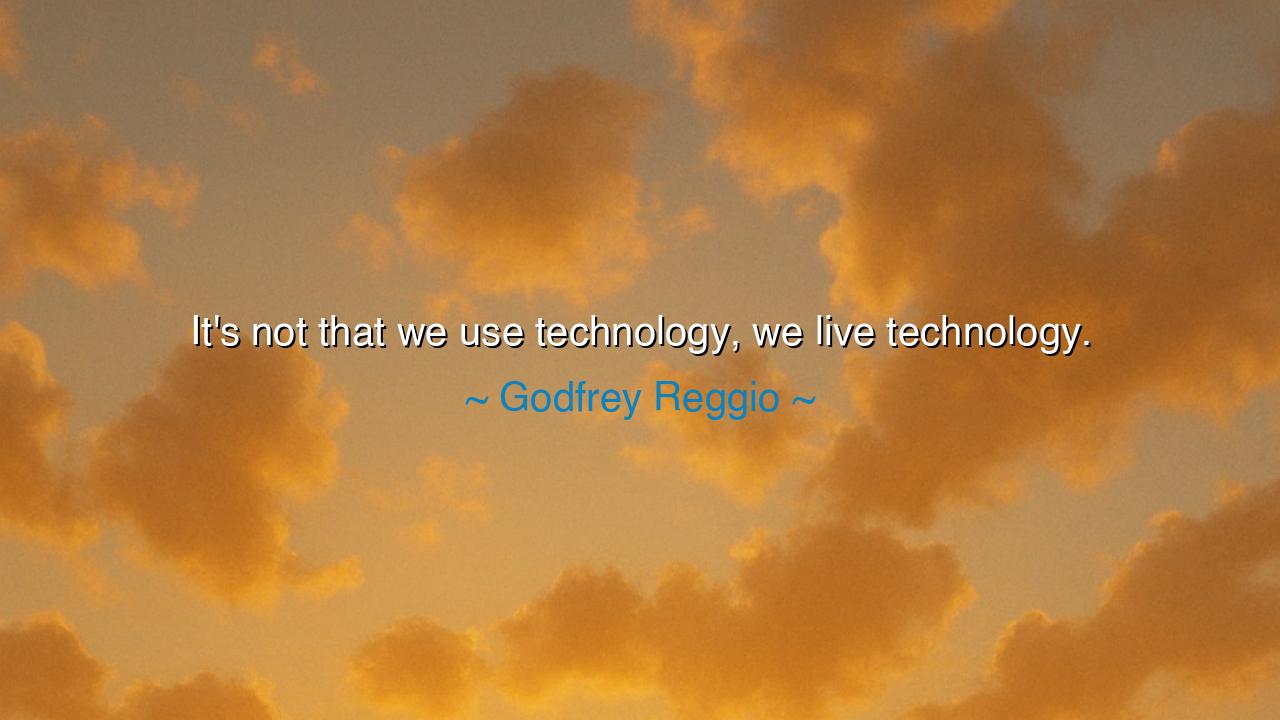
It's not that we use technology, we live technology.






Hear the words of Godfrey Reggio, the visionary filmmaker whose work revealed the silent pulse of modern civilization. He declared: “It’s not that we use technology, we live technology.” These words strike like a gong in the temple of our age, reminding us that technology is no longer a mere tool in our hands, but the very air we breathe, the water in which we swim, the unseen fabric that shapes our lives from birth until death.
The meaning of this wisdom is profound. Once, technology was a servant—an axe to cut wood, a wheel to carry burdens, a plow to till the earth. Man stood apart from his tools, using them when needed, putting them down when the task was complete. But in our age, technology is no longer separate. It has woven itself into our rhythms of sleep and work, into our communication and imagination, into our very sense of what it means to be human. We no longer simply use it—we live within it, as fish live in the sea.
The origin of this insight lies in Reggio’s own vision as seen in his film Koyaanisqatsi, where images of nature and humanity are contrasted with the machinery and frenzy of modern life. He saw that technology had become invisible by its omnipresence. Like the earth beneath our feet, it is taken for granted, yet it silently defines the shape of our existence. His words are less a condemnation than an unveiling: to awaken us to what we have become, to make us conscious of the water we cannot see because it surrounds us entirely.
History offers a mirror to this truth. When the Industrial Revolution dawned, workers believed they were merely “using” the new machines to increase production. Yet in time, the machine altered not just their labor but their families, their cities, their very patterns of thought. The clock tower became the ruler of time, discipline replaced the freedom of craft, and life itself became synchronized to the heartbeat of the factory. They were not simply using machines—they were living the machine, their identities reshaped by it.
So too in our present day, consider the rise of the smartphone. At first, it was but a device—a tool for calls, messages, and convenience. Yet it has grown into a constant companion, a silent witness to every moment. It mediates friendships, records memories, directs travel, delivers knowledge, and even governs how attention flows. For millions, to be without it is to feel incomplete, as though a limb has been severed. Thus Reggio’s words prove true: we no longer merely use technology—we dwell inside it.
The lesson of this truth is urgent. If we live within technology, then we must awaken to its power over our souls. To live unconsciously in it is to risk being shaped without knowing, molded into forms not of our choosing. But to live consciously is to take back mastery, to decide how these forces will guide us, to remind ourselves that though we live in technology, we must not let it erase our humanity.
Therefore, O children of tomorrow, be watchful. Do not despise technology, for it carries wonders and blessings, but do not worship it either. Let it be the water in which you swim, but never forget you are the swimmer. Create spaces of silence and presence, where the human heart can breathe without mediation. Reclaim music, conversation, and nature as anchors that remind you of your essence. For if you live technology, you must also live consciously, lest you lose yourself in the tide.
Thus remember Reggio’s wisdom: It’s not that we use technology, we live technology. Take it as a call to awareness, a call to stewardship. Live within it, but live with eyes open, with heart steady, and with soul unbound. Only then will the sea of machines serve as an ocean of possibility, and not a storm that swallows us whole.






AAdministratorAdministrator
Welcome, honored guests. Please leave a comment, we will respond soon